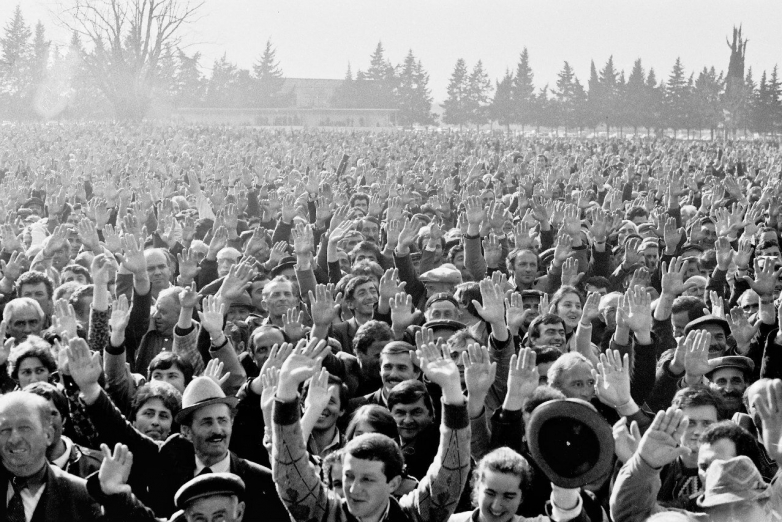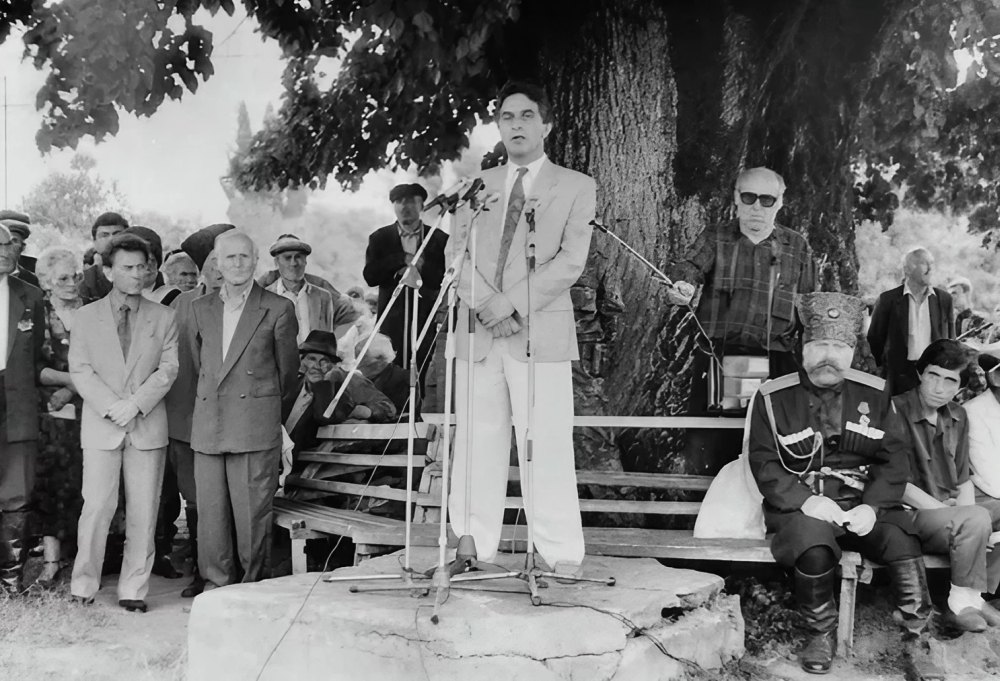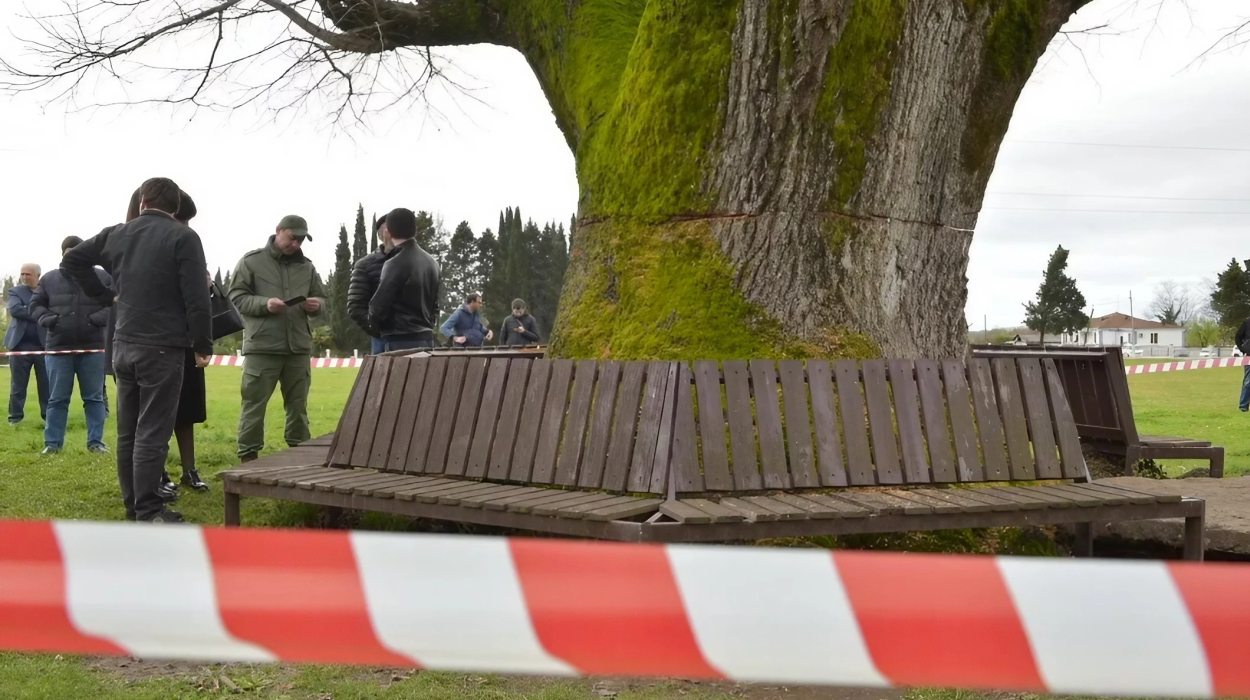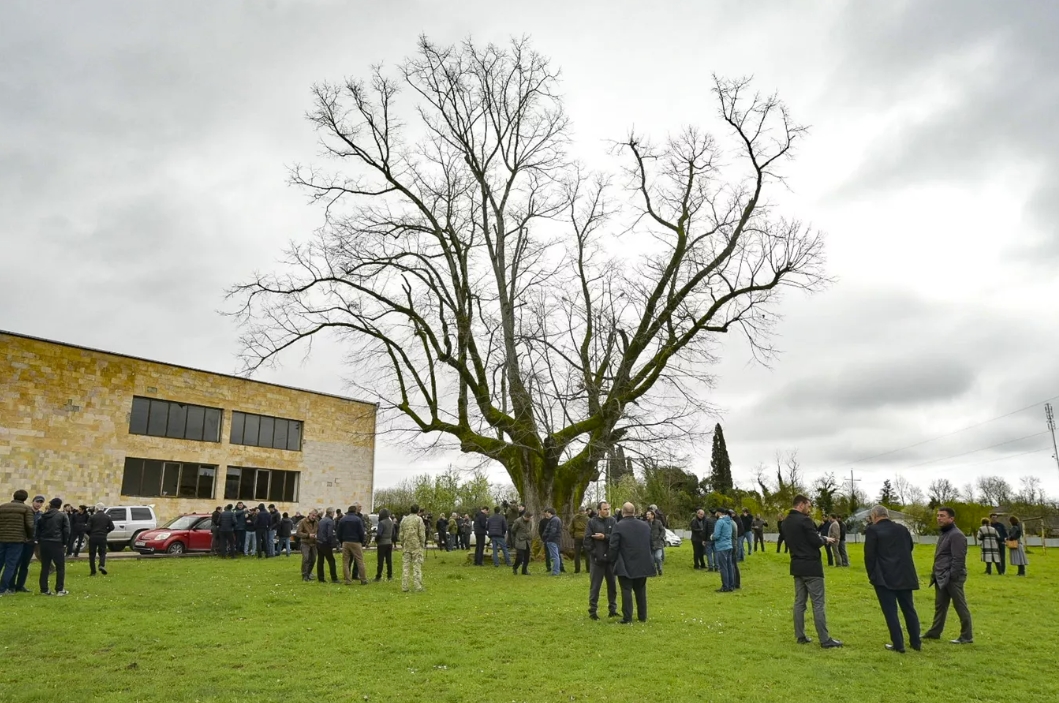Attempt on the Spiritual Symbol of Abkhazia, by Vitaly Sharia

Unknown individuals vandalized centuries-old linden tree in the historical Lykhnashta glade.
Ekho Kavkaza ― Yesterday, around eight or nine in the evening, the Abkhaz segment of social media was stirred up by a short video showing a deep chainsaw cut around the trunk of a Caucasian linden tree in the village of Lykhny. As I was browsing my Facebook feed at the time, I could see that there had never been so much attention to the incident - every second user reposted the video, posting it on their Facebook page. Messages from the media were also posted, quoting biologists' opinions on the fate of the tree, and reporting that representatives of the authorities, including Prime Minister Alexander Ankvab, had arrived at the scene.
A person unfamiliar with Abkhaz reality might wonder why there is so much noise and emotion over a damaged tree. But one must know at least a little bit about the history of Abkhazia. The issue is not only and not so much the age of the tree (most authors of posts and commentators said it was over one hundred and fifty years old, while the Vice President of the Academy of Sciences of Abkhazia, leading Abkhaz botanist Sergey Bebia, claims it is two hundred years old), but the fact that this place is historically very important, even sacred, for the Abkhaz people.
In February, "Ekho Kavkaza" told the story of the Duripsh peasant multi-day gathering in 1931, when on one of the days its participants gathered in Lykhny, and in general about the history of Abkhaz popular gatherings, which should not be confused with political rallies of recent decades. So, in Abkhazia, the concept of "popular gathering" is most often associated with Lykhnashta, or as it is called in Russian, Lykhnenskoy polyanoy (Lykhny Meadow) - a spacious, grassy area larger than a football field, with an ancient Orthodox church on one side, and the ruins of a princely palace of Abkhazia on the other, destroyed after the Lykhny uprising of 1866, and the current village Palace of Culture. By the way, one author, Alexey Gubaz, insisted in print that it should be called not a meadow, but a Palace Square in Russian. It is there, near these palaces, former and present, that the linden tree stands tall.

On March 18, 1989, in the very heart of Abkhazia, in a historic place on a field in the village of Lykhny. For many centuries, the Abkhaz people convened here to make all crucial decisions for their country.
It was here that the multi-thousand-strong gathering took place on March 18, 1989, which adopted the Lykhny Appeal to the leadership of the USSR. It was here, under this linden tree, that Vladislav Ardzinba stood in October 1992 and addressed the participants of the popular gathering, protesting against the actions of the State Council of Georgia's troops in Abkhazia. By the way, a photo of the gathering where Vladislav and his comrades stand under this tree was also posted on Facebook today.

Vladislav Ardzinba speaking at a national gathering in the village of Lykhny during the war.
The legendary Caucasian linden tree has been a witness to numerous momentous events, including political gatherings in 1866, 1931, 1978, and 1989. One of the most famous events held under the tree was the Lykhny Declaration, which demanded the restoration of Abkhazian sovereignty on March 18, 1989.
+ Lykhny Uprising, or translation-difficulties: what happened in 1866
+ Unity in the name of freedom: for the anniversary of the 1989 Lykhny appeal
So, what happened to the linden tree? As reported in the media, on the evening of April 5, residents of houses near Lykhny Meadow heard the sounds of a working chainsaw but could not imagine that someone might be cutting down the ancient linden tree. The head of the Gudauta Police Department, Zosma Gitsba, said that law enforcement officers arrived at the scene, questioned everyone, and investigative measures are being carried out. The qualification of this case has yet to be determined jointly with the prosecutor's office. The incident is likely to be classified as vandalism, which could lead to criminal liability. He added that all law enforcement services of the country are involved in the investigation of the incident, as the location and the tree itself have historical significance for Abkhazia.
+ Vandalism at Historic Lykhnashta Glade: Linden Tree Damaged, Abkhazia in Shock
+ Centuries-Old Linden Tree in Lykhny Unlikely to Survive Vandalism, Says Scientist
+ Abkhazian Officials Respond to Centuries-Old Tree Vandalism in Lykhnashta Meadow
+ In Pictures | Preserving Life: Saving a Linden Tree in the Village of Lykhny
According to Roman Dbar, the director of the Institute of Ecology, the tree is unlikely to survive. "It is currently the period of spring sap movement, and considering the depth of the cut, the chances of the linden tree surviving are slim," he said. He added, "Lykhny Meadow is a historical place. People gathered near this tree to make crucial decisions for the country. It symbolizes the resilience and spirit of the people."
Sergey Bebia shares the same opinion: "The tree will have to be cut down; otherwise, it will dry out within a year. If it is cut down, there is a chance it will send out new shoots."
However, some online commentators shared folk methods for saving the linden tree. For example, Nadezhda Lyutakhina provided a detailed recipe for using garden grafting: "I wouldn't condemn the tree to death; it's worth fighting for."

Tengiz Dzhergenia, the chief forester of the Ritsa National Park, explained that "bridges" could be made from young cuttings of the tree, which would transfer nutrients from the lower part to the upper part during the sap movement period.
As for the motives behind the act, all commentators agreed that it was a "spit in the soul of the people." While some saw it as a planned operation: "At all costs, the organizers must be found," others argued against conspiracy theories, suggesting that it might be just someone's foolish act: "Everything unattended that is being cut down is of no concern to anyone."
Today, I called the well-known Abkhaz historian Soslan Salakaya, who previously spoke to Echo of the Caucasus about the Lykhny Uprising. I decided to clarify with him:
During the Lykhny Uprising, was this linden tree already there?
- Yes, it was. People held public trials and oratory competitions near it... So it is indeed 200 years old.
By the way, there is a similar linden tree on the other side of the meadow, near the church.
- Yes, yes. There are two linden trees. Someone once wrote that there was an oak, but it's not correct. Caucasian linden trees grow in Lykhny Meadow.
Well, what do you think happened? Everyone is guessing now.
- I don't know. Most likely, it's some kind of provocation. Most likely. Otherwise, who could have done this out of ignorance or foolishness?
But what is the purpose of the provocation, and who is it aimed against?
- Well, you know, many attribute a sacred meaning to it... Maybe it's too conspiratorial a theory, but it's just... Who could think of doing this without being seen?"
Today, in my Facebook feed, I saw a large photo of people standing in front of that very linden tree, with the caption: "People are gathering at Lykhnahta since morning."

Here are a few of the latest internet comments:
"With the help of this tree, our people are rising to spiritual enlightenment. People pray there. One must be so brainless to raise a hand against it.";
"I think it's a sign from our enemies! It means - we will cut down your state like this!";
"My soul aches. These cuts on the tree are like a knife to the heart. It's simply incomprehensible - how, why, and for what? This will not be forgiven by whoever did it."
This article was published by Ekho Kavkaza and is translated from Russian.